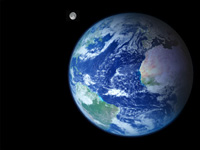Earth may be older than previously thought
Earth took present shape approximately 4.5 billion years ago. Its original appearance has not changed ever since. The planet became suitable for conceiving and developing life forms from the very first minutes of existence. An international team of scientists has recently announced that a number of theories about the continental crust being melted out of water, which covered the earth completely at the early stages, are erroneous.

In short, the story of the discovery stems from a find in the Jack Hills mountain range in Western Australia. The range is considered the oldest on Earth, it is 4.4 billion years old. Scientists found a rare-earth metal hafnium in combination with the crystals of zirconium. A radio-isotopic analysis revealed that the continental crust had formed 4.4 billion to 4.5 billion years ago i.e. right after the birth of the planet. It was previously thought that the continental crust had melted out of the oceanic one.
“Looks like Earth assumed form in the wink of an eye,” says Dr. Steven Moizcis, one of the researchers, at the University of Colorado . “All present-day concepts concerning history of the formation of Earth will have to be revised if the supposition proves correct. Scientists will probably have to thoroughly study the civilizations of Atlanteans and other forefathers. Those civilizations looked totally fictitious in the past. Assuming that a protein life form had existed on Earth several billion years ago, those civilizations no longer look otherworldly,” says Moizcis.
A study conducted by Dr. Moizcis-led team indicates that water came into being on the earth’s surface about 4.3 billion years ago. Contrary to the previous theories, water did not condense from the atmosphere 3.8 billion years ago. According to Dr. Moizcis, oceans and atmosphere have existed from the very start and Earth was fit for living in those prehistoric times.
“Several dozen theories of the origins of Earth have been put forward during the long history of science,” says Valery Rudakov, chief researcher at the Institute of Physics of Earth under the Russian Academy of Sciences. “The Buffon theory was quite popular at the beginning of the 20th century. According to the theory, the Sun was a white-hot melted mass, which collided with a comet. A hot piece of the Sun was torn away and thrown into space where it broke into several parts. The parts formed the planets that circled around the Sun because of the centrifugal and centripetal forces. In this way the planets might be parts of heated solar matter and therefore they were equally heated, according to Buffon. The gradual lowering of temperatures on the earth’s surface led to the inception of life. At the same time, the theory maintains that the cooling will continue. First the cooling will decrease the variety of organic life forms on Earth, eventually it will kill them all,” says Valery Rudakov.
The theory of a continental drift, the theory of plates’ tectonics, the theory of convectional currents, and Schmidt’s theory of meteoritic origins – all the above were considered the most plausible theories of the 20th century. Schmidt’s theory, for example, says that solid particles of a gaseous dust cloud attracted by the Sun formed the solar system. However, none of the theories could paint a clear picture of what was going on millions and billions years ago. No matter how different the theories may be, each of them stresses gives emphasis to the assertion that no life forms could have existed on Earth at the very beginning.
“Perhaps the bold theory put forth by European scientists will enable them to shed light on many issues,” says Valery Rudukav. “However, it would be rather premature for them to arrive at conclusions by using only the findings made so far,” adds he.
Nezavisimaya Gazeta
Subscribe to Pravda.Ru Telegram channel, Facebook, RSS!





